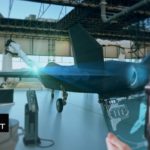Technology is changing the way airpower works and redefining what dominance is all about.
Annabel Flores, Vice President of Electronic Warfare Systems at Raytheon, Intelligence and Space talked to FINN about the technologies critical for enabling dominance in today’s battlespace.
Flores said investment had shifted towards additional sensors and electronic warfare within the National Defence Strategy, marking the shift from dealing with terrorism to new threats.
“In air dominance, it really is a suite of different solutions that are really necessary to give that pilot that edge to be able to effectively complete their mission,” she explained. “So we’re talking about all sorts of different capabilities that are required. Enhanced radars, enhanced electronic warfare, which is everything from jamming to radar warning receivers, enhanced capabilities, in terms of sensors for IR for just additional situational awareness, and then all the way to effects that are required in this new scenario.”
“So it really is almost a wholesale advancement, an upgrade of what our pilots currently have to be able to compete in this mission and be able to accomplish their objectives.”
Solutions are needed on a tight budget
But despite the new technological developments, tighter budgets mean adaption and added capabilities, rather than wholescale reinvention. New systems are being designed for existing platforms without the need for costly wholesale redesign or lengthy timeframes.
She explained: “Our pilots need solutions now in a very tight budget. So what we’re doing within Raytheon Technologies is really taking our existing systems and adding that incremental investment and incremental capabilities so that we can effectively get them to the fight today, as well as increasing that capability in the future. Because it’s not just about air dominance today. It’s about maintaining that. And a lot of what we’re putting into our solutions within Raytheon Technologies is open architecture.”
“Open architecture really allows us to develop hardware today that we can then upgrade continuously. So the pilot will always have the latest capability to maintain that air dominance, with whatever mission they’re trying to accomplish.”
Threat has moved from terrorism to technological warfare
Terrorism has been the focus of both budget and attention for the last 20 years. But with threats moving from terrorism towards technological warfare, Raytheon has expanded its capabilities – bringing Collins and Pratt & Whitney under one roof – enabling the company to tackle new adversaries.
Flores said: “The F-35 is a great example of how all of these different pieces come together to enable this great platform to really continue their air dominance legacy as we continue to move forward. So intelligence in space provides some of this capability. We talked about some of the jamming, we’ve talked about some the radar warning receivers, Collins has helmet displays.”
“And so when you go from the entire Kill Chain of what we have from sensors and systems that provide that all the way to the J Pals, which is a safe landing system that enables the pilot to operate safely, we really are talking about increasing the safety of the pilot, increasing their effectiveness, and whatever they’re doing whatever environment they’re in.”

